If you have been diagnosed with low thyroid function, or hypothyroidism, you and your doctor have a number of medications to choose from.
As a Naturopathic Physician, my focus is to choose the medication that fits your needs, to individualize your prescription so that you are adequately treated and your symptoms are relieved.
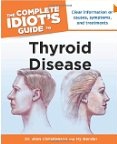 If you have researched thyroid disease and treatments, no doubt you have come across widely different approaches and convincing arguments for each. I will not go into those here.
If you have researched thyroid disease and treatments, no doubt you have come across widely different approaches and convincing arguments for each. I will not go into those here.
I encourage you to actively participate in your medical decisions, and encourage a balanced approach. Getting into an adversarial relationship is not productive, and a mix of openness and skepticism will most likely bring you to your most appropriate treatment.
One authoritative and balanced resource I recommend is The Complete Idiot’s Guide to Thyroid Disease, by Dr. Alan Christianson and Hy Bender.
The purpose of this article is to discuss natural thyroid medications to bring distilled information to your open skeptical mind.
Natural vs Synthetic
Natural thyroid medications are prescription medications made from the thyroid glands of pigs. You might find it called
- Desiccated thyroid
- Glandular thyroid
- Natural Desiccated Thyroid
- NDT
It is the only thyroid medication that contains all four thyroid hormones that our bodies make: T4, T3, T2, and T1. In addition, its iodine, thyroglobulin protein and glandular tissue content have useful functions in the body.
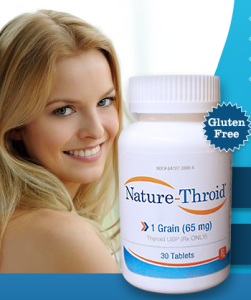 Trade names of this Natural Desiccated Thyroid include:
Trade names of this Natural Desiccated Thyroid include:
- Acella – NP Thyroid
- Armour thyroid
- Nature-Throid
- WesThroid
- WP Thyroid
In addition, compounding pharmacies may use whole desiccated thyroid porcine glandular in their individualized prescriptions.
Most mainstream doctors prescribe a thyroid medication that is synthesized from chemicals in a lab and contains the hormone T4 only. This is available in both trade name brands and generic forms. Synthroid is in the top 10 most 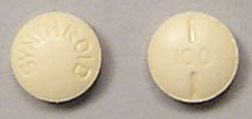 commonly prescribed medications. Common forms include:
commonly prescribed medications. Common forms include:
In addition, synthesized T3 hormone is available by prescription as well as compounded. The brand name is Cytomel and the generic form is known as liothyronine.
Women’s International Pharmacy has compiled a chart of thyroid hormone therapy options which make it easy to evaluate. It contains additional useful information and may be accessed here: thyroid_hormone_therapy_options.
Advantages of Natural Desiccated Thyroid
- A natural mix of all 4 thyroid hormones T4, T3, T2, T1
- T4 is the predominant thyroid hormone produced by our thyroid glands, but it is minimally active until converted to T3
- A small amount of the metabolically active T3 helps people who don’t effectively convert their T4 into T3
- Contains thyroglobulin protein which slows the breakdown of T3, the active hormone so that it will keep you going all day without having to dose again during the day
- T2 has been found to play a role in metabolism and fat burning
- The glandulars in the NDT can help strengthen and rebuild you own thyroid gland, provided you still have it
- Also one grain NDT contains 120 micrograms of iodine. The adult RDA is 150 mcg, with the WHO (World Health Organization) recommending 220 mcg for pregnant women.
- Relatively low price – pigs thyroid glands are sold at a low cost to manufacturers
- No one can patent a pig thyroid gland, so name brands are already at generic prices
Disadvantages of Natural Desiccated Thyroid
- Comes from a pig, which is objectionable to vegetarians, Orthodox Jews and other religious groups, and others who find it distasteful
- A smaller range of dosages available than the synthetic, so sometimes a combination of pills must be used to get in-between dosages
- At times, there has been a “shortage” of natural raw materials, limiting its availability
- Many mainstream doctors will flat-out refuse to prescribe it
Issues which are debatable as advantages / disadvantages
T4:T3 ratio
The human thyroid gland makes a ratio of T4 to T3 of approximately 10 to 1. The pig gland in NDT contains a ratio of 5 to 1. This makes an excess proportion of T3. Some patients can use this higher proportion if they have trouble converting T4 to T3. In addition, there is some evidence that in cells, the proportion of T4 to T3 is closer to the 5 to 1.
Standardization
The first thyroid hormone supplements came from animal glandular tissue. At that time, the potency was determined by measuring its iodine content, because that was the best technology could do.
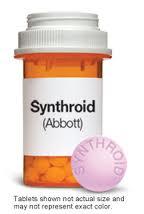 In 1955, Synthroid first came to the market. In an aggressive marketing campaign, it was promoted as new and modern and the desiccated thyroid was portrayed as old fashioned and inconsistent from batch to batch. Then there was a report in a major medical journal of one patient who was severely under-treated due to the inconsistency of the natural desiccated thyroid. This sealed the fate of NDT in some physician’s minds and showed the shining advantage of the money-maker Synthroid.
In 1955, Synthroid first came to the market. In an aggressive marketing campaign, it was promoted as new and modern and the desiccated thyroid was portrayed as old fashioned and inconsistent from batch to batch. Then there was a report in a major medical journal of one patient who was severely under-treated due to the inconsistency of the natural desiccated thyroid. This sealed the fate of NDT in some physician’s minds and showed the shining advantage of the money-maker Synthroid.
All thyroid hormone medication manufacturers must follow the guidelines of the United States Pharmacopeia (USP), a highly respected authority which sets the standards. With the advent of new technologies in the mid-1980’s, natural desiccated thyroid manufacturers could now measure the actual amounts of T3 and T4 in their pills. So now there is absolutely no difference in standardization between synthetic and natural forms of thyroid, as long as the manufacturers are adhering to the standards.
In fact, the USP standard allows a 10% variation in T4 and 10% variation in T3 in the manufacture of thyroid medications. This can account for some of the brand variations. And look at the history of recalls on medications due to mistakes: synthroid has had several and so has Armour.
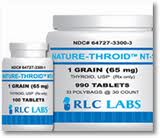 RLC labs stands out from all the other manufacturers in that their in-house policy is to only allow less than or equal to 2% variation in the T3 and T4. RLC labs tablet natural desiccated thyroid into
RLC labs stands out from all the other manufacturers in that their in-house policy is to only allow less than or equal to 2% variation in the T3 and T4. RLC labs tablet natural desiccated thyroid into
- NatureThroid
- WesThroid
- WP Thyroid
And they have had no recalls.
Natural Desiccated Thyroid and Autoimmune Thyroid
It is thought in some circles that Natural Desiccated Thyroid will aggravate patients with Hashimoto’s autoimmune thyroid condition. The thinking is that there is an immune attack on the enzyme thyroperoxidase and the protein thyroglobulin when it is released from the NDT, perpetuating the autoimmune attack.
Wow, this could be huge and sounds viable in theory. I have had a few patients who did not respond well to NDT, but I was not able to determine if it aggravated an autoimmune attack or if there was some filler ingredient they did not tolerate.
A literature review has not shown any evidence of the theory, though. In fact, one citation showed NDT was actually beneficial because it induced tolerance, calming the immune attack, instead of aggravating the condition.
What distinguishes NDT medications – The Issue of Fillers
Why can’t medication manufacturers just put the thyroid in a pill and leave it at that?
Why are there fillers?
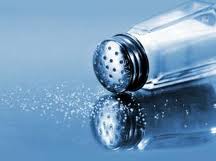 Thyroid hormone is so very potent that the body only makes about 94-110 micrograms T4 and 10-22 micrograms T3 daily.
Thyroid hormone is so very potent that the body only makes about 94-110 micrograms T4 and 10-22 micrograms T3 daily.
To appreciate how little this is, a milligram is less than a grain of salt, so 100 micrograms of T4 is one-tenth of that and 10 micrograms of T3 is one-onehundredth of that!
So if a thyroid medication has 38 micrograms of T4, you can appreciate how tiny an amount that is. That is why there are fillers.
Now, at first the manufacturers used cornstarch and other problematic fillers. Some people still have undesirable reactions to the fillers. Current commonly used one include:
- Microcrystalline Cellulose
- synthetically derived fiber base
- utilized to provide volume and bulk
- Dicalcium Phosphate
- derived from a mined ore
- utilized as a binder to hold all the ingredients together during tableting
- Colloidal Silicon Dioxide
- derived from a mined ore
- utilized as a natural desiccant to ward off moisture and humidity
- Sodium Starch Glycolate
- Synthetically derived starch molecule
- utilized for proper disintegration of the tablet in the stomach
- Magnesium Stearate
- Derived from a vegetable source
- utilized as a lubricating agent so the tablet doesn’t stick to the molds
- Hydroxypropyl Methylcellulose
- Derived from a plant cellulose base
- utilized to provide bulk and density to the tablet for proper compression
- also part of a clear coating solution
- Polysorbate 80
- an inactive water soluable emulsifying agent
- blends the ingredients to prevents separating
- Stearic Acid
- Derived from a vegetable source
- utilized as a binder to hold all the ingredients together during compression
- Carnauba Wax
- Derived from the pores of the leaves of the Brazilian wax palm tree
- utilized to provide a complete seal in the final stage in tablet coating
- Polyethylene Glycol (PEG)
- Synthetically derived, water-soluble, waxy solid.
- utilized with Hydroxypropyl Methylcellulose as part of the clear coating solution.
- Lactose Monohydrate
- Present in traceable amount as part of Thyroid USP
- diluent for the NDT powder
Is there an alternative?
 RLC labs has produced a “Pure” form of its WesThroid called WP Thyroid (formerly called Westhroid-P) which not currently available.
RLC labs has produced a “Pure” form of its WesThroid called WP Thyroid (formerly called Westhroid-P) which not currently available.
It only has two natural inactive ingredients:
- inulin from chicory root (a natural fiber)
- medium chain triglycerides from coconut (easily absorbable fats)
It is interesting to note that the formulations of the WesThroid and NaturThroid have been identical for years. They continue to make both because of name recognition.
It turned out that they were more easily able to gain an alteration of the WesThroid so that is this new product. Effective August 2013, RLC labs changed the name of the product form Westhroid-P to WP thyroid to minimize confusion between the existing Westhroid and Westhroid-P.
Let’s hope it will become available again soon.




